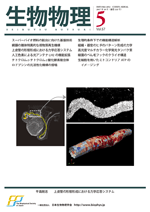
- |<
- <
- 1
- >
- >|
-
Tatsuo IWASA2017Volume 57Issue 5 Pages 231
Published: 2017
Released on J-STAGE: September 26, 2017
JOURNAL FREE ACCESSDownload PDF (112K)
-
Osamu IWATA, Koji YAMADA, Takuro ITO, Yasuyuki OZEKI, Kengo SUZUKI, Ke ...2017Volume 57Issue 5 Pages 235-239
Published: 2017
Released on J-STAGE: September 26, 2017
JOURNAL FREE ACCESSRecent technological advances have enabled microalgae-based engineering of bioproducts. Microalgae have a higher photosynthetic efficiency than plants and can be cultivated in agriculturally unused land, which has helped us mass-produce microalgae such as Euglena gracilis. E. gracilis is a unicellular microalgal species found in freshwater and is an attractive species for producing lipids which can be converted into biofuels. However, its lipid production efficiency is low and unable to meet high demands from the competitive fuel market. In this article, we review a few innovative methods for developing super biofuels based on super microalgae that are anticipated to overcome the low lipid production efficiency.
View full abstractDownload PDF (951K) -
Shinya SATO2017Volume 57Issue 5 Pages 240-243
Published: 2017
Released on J-STAGE: September 26, 2017
JOURNAL FREE ACCESSVertebrate visual photoreceptor cells, rods and cones, consume 11-cis-retinal as a chromophore of visual pigment. 11-cis-retinal is supplied from two metabolic pathways; the retinal pigment epithelium pathway, which is common for both rods and cones, and the cone-specific intra retina pathway. The latter pathway is thought to support a rapid re-synthesis of 11-cis-retinal which is required for cone-mediated daylight vision. Recently, it was proposed that 9-cis-retinal, in addition to 11-cis isomer, is used in this cone-specific pathway and it might modulate sensitivity and spectral tuning of cone-mediated vision. This review summarizes our recent studies to test this hypothesis.
View full abstractDownload PDF (555K) -
Tsuyoshi HIRASHIMA2017Volume 57Issue 5 Pages 244-248
Published: 2017
Released on J-STAGE: September 26, 2017
JOURNAL FREE ACCESSMechanical forces play pivotal roles in tissue morphogenesis at various scales. Taking developing murine epididymal tubule as an example, I explain about the role of mechanical forces in the tube morphogenesis in this review. First, I show that the tubules undergo wavy pattern formation during the development and the pattern formation at tissue scale occurs by mechanical instabilities due to axial compressive forces. Second, I show that the cells actively move in response to mechanical forces provided by dividing cells within the tubule, leading to generation of the axial compressive forces.
View full abstractDownload PDF (902K)
-
Takehisa DEWA, Yutaka NAGASAWA2017Volume 57Issue 5 Pages 249-251
Published: 2017
Released on J-STAGE: September 26, 2017
JOURNAL FREE ACCESSDownload PDF (1191K) -
Satoru SHIMADA, Kyoko SHINZAWA-ITOH, Tomitake TSUKIHARA2017Volume 57Issue 5 Pages 252-253
Published: 2017
Released on J-STAGE: September 26, 2017
JOURNAL FREE ACCESSDownload PDF (495K) -
Naoki KIMATA2017Volume 57Issue 5 Pages 254-256
Published: 2017
Released on J-STAGE: September 26, 2017
JOURNAL FREE ACCESSDownload PDF (365K) -
Satomi INABA2017Volume 57Issue 5 Pages 257-258
Published: 2017
Released on J-STAGE: September 26, 2017
JOURNAL FREE ACCESSDownload PDF (417K) -
Hiroshi KOYAMA, Dongbo SHI, Toshihiko FUJIMORI2017Volume 57Issue 5 Pages 259-261
Published: 2017
Released on J-STAGE: September 26, 2017
JOURNAL FREE ACCESSDownload PDF (619K) -
Kazushi SUZUKI, Takeharu NAGAI2017Volume 57Issue 5 Pages 262-264
Published: 2017
Released on J-STAGE: September 26, 2017
JOURNAL FREE ACCESSDownload PDF (1158K) -
Hideyuki MATSUNAMI2017Volume 57Issue 5 Pages 265-267
Published: 2017
Released on J-STAGE: September 26, 2017
JOURNAL FREE ACCESSDownload PDF (546K) -
Takumi KOSHIBA, Hiromi IMAMURA2017Volume 57Issue 5 Pages 268-270
Published: 2017
Released on J-STAGE: September 26, 2017
JOURNAL FREE ACCESSDownload PDF (550K)
-
[in Japanese], [in Japanese], [in Japanese], [in Japanese], [in Japane ...2017Volume 57Issue 5 Pages 272-273
Published: 2017
Released on J-STAGE: September 26, 2017
JOURNAL FREE ACCESSDownload PDF (530K)
-
[in Japanese]2017Volume 57Issue 5 Pages 274-275
Published: 2017
Released on J-STAGE: September 26, 2017
JOURNAL FREE ACCESSDownload PDF (203K)
-
[in Japanese]2017Volume 57Issue 5 Pages 276-277
Published: 2017
Released on J-STAGE: September 26, 2017
JOURNAL FREE ACCESSDownload PDF (230K)
-
[in Japanese]2017Volume 57Issue 5 Pages 278
Published: 2017
Released on J-STAGE: September 26, 2017
JOURNAL FREE ACCESSDownload PDF (245K)
-
2017Volume 57Issue 5 Pages 271
Published: 2017
Released on J-STAGE: September 26, 2017
JOURNAL FREE ACCESSDownload PDF (144K)
- |<
- <
- 1
- >
- >|